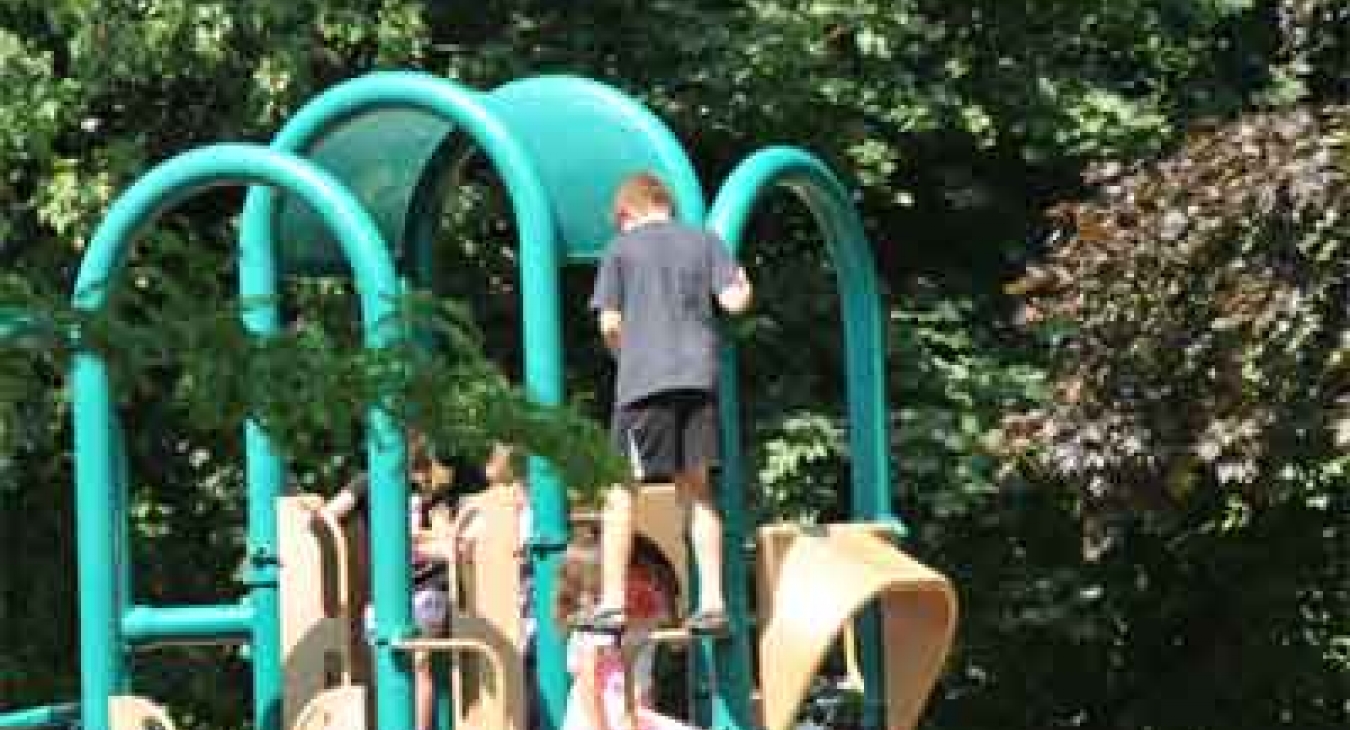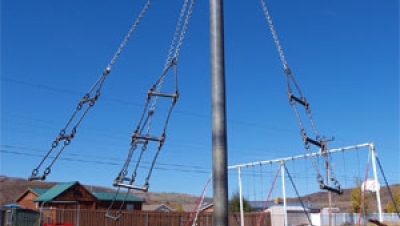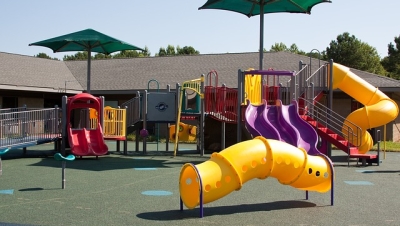Risk taking play on playground equipment
There is an emerging trend in playground equipment standards development. The focus of the hazard based approach is to embrace reasonable foreseeable playground related injuries regardless of what the equipment might be called, what specific category it appears to fit into, or what the equipment looks like. The United Kingdom’s approach to this risk assessment and hazard based approach may sound quite familiar but one country’s interpretation of what constitutes a hazard or what is an unacceptable injury rests within the societal differences of each; after all, who is right hinges on who is in charge.
Background
The American public playground equipment injury prevention movement was born more than 40 years ago as a result of many research projects of the United States Consumer Product Safety Commission (CPSC). The CPSC injury prevention and safety staff along with other child development and play advocates have been reacting to injury reports and statistics. Initially this approach to injury prevention has been very effective in many areas. Today we can no longer meet the change of pace in product development throughout the playground equipment industry.
We continue to chase our tails expending a lot of human and financial resources only to find ourselves back in the same place we started or we are expending too much time changing what we already have done. We seem to be considering more exceptions to the rule than to modify the rule in the first place. Either way our actions seem focused on allowing for some new piece of equipment rather than requiring the new equipment meet the basic requirements for hazard mitigation. In essence, our current approach to creating and revising playground safety guidelines and recommendations could be compared to the farmer closing the barn door long after the livestock has left the barn.
So how does the hazard based approach differ from the continual need to expand the specific equipment requirements? The answer to the first part of the question is easy. Sections 4, 5, 6 and 7 of ASTM International (ASTM) F1487 and primarily Section 6, cover almost every hazard based performance requirement for any piece of play equipment no matter what it is called.
Once we get into Section 8 Equipment, the performance requirements start to become more design restrictive. When injury reports become more widely known by the general public and lawsuits get filed, the injury prevention folks start to do their job. Is this necessary or is it a knee-jerk over-reaction?
Follow up investigation analysis after a serious injury seems to be done as if the injury occurred within a workplace environment. Unfortunately, the public playground environment is starting to be compared to a place of employment, which it is not. In the workplace, the employer is responsible for their employees’ safety. In the adult world, we are concerned with loss of productivity, lost income, and medical and rehabilitation costs. Most workplace environments have very strict State and Federal Occupational Health and Safety Act (OSHA) requirements. Any shortcomings uncovered in OSHA inspections lead to corrective action and often fines to the owner of the workplace. Workplace injuries often lead to new performance requirements. Over time this has proven to be a good thing as improvements within the workplace have eliminated the cause of many future injuries.
I am not saying we should take this approach in a hazard based analysis of play spaces. I have stated before that children’s play spaces are not to be treated as a workplace environment. There are obviously the medical and rehabilitation costs like with adults, but provided the injury does not exceed a societally acceptable threshold, the injury becomes an acceptable outcome to a failed learning experience. It is worth repeating, “Children’s play space injuries should not be treated the same as workplace injuries.” Workplace injuries, for the most part, are not acceptable in today’s society, even when they are unforeseen. This is especially true when an employer could have taken action to eliminate the cause of the injury either by warning signage, employee training, additional safety equipment/tools, or new improved facility and equipment designs.
A public play space’s purpose is much different than almost all places of employment where the primary purpose is to create a product or service while creating wealth for the company’s shareholders and its workers. A play space is a place for young rather inexperienced children to explore their abilities, assess play opportunities, and take risks; a place to try things for the first time even when the outcome is unknown. It should be a requirement that each play space be a place for less rules not more. It should be treated as a place to enjoy free time. It is a place to explore everyone’s individual capacity to grow and learn new things about themselves and the environment around them.
Imagine what the adult workplace environment would be like if these ideas and principles were to be applied. Some would argue chaos would prevail. Many successful companies have what could be called an unstructured or chaotic environment, but invariably hazards to people or property are cleverly removed. Workplace rules are designedto protect the employee and to protect the company from the ever increasing onslaught of Worker’s Compensation claims and cover situations where the injured employees do not follow workplace procedures resulting in a preventable injury.
Obviously children cannot be held to the same standard of behavior. I would argue the playground owners and equipment and surfacing manufacturers also should not be the scapegoat whenever obvious or blatant inappropriate personal behavior and lack of supervision lead to the unfortunate injury. I want to be clear that I am not looking to absolve anyone from a defective product, improper installation, lack of adult supervision, or a lack of inspections, maintenance, and corrective action. This is a whole different story. Hazard elimination must be unobtrusive, and it results from ongoing adult assessment and review of the play space.
For the hazard based approach to playground standards to move forward the playground equipment design and play space post injury investigation cannot be measured in the same way as the workplace environment. Society must first set an acceptable threshold for injury. Today we are debating if this will be based solely on prevention of death or life-threatening as it was 40 years ago or be focused more on concussion and long-bone injury or those defined by the CPSC as a societal surrogate in the U.S. Consumer Product Safety Improvement Act (CPSIA). The goals and objectives are quite different for each environment. Regardless, the manufacturer and designer of the playground equipment and use zone surface system should be conducting their own risk assessment of the prototype piece of equipment or new surfacing system to determine whether or not it is appropriate for the intended user regardless of any reasonable foreseeable misuse by the child/user.
Where does the responsibility lie for children's safety on the playground? Playground owners? Playground managers? Designers? Safety inspectors? Yes!
So how does this new hazard based approach get implemented?
A colleague of mine read my response in the “NRPA Connect” Playground Safety Forum on a question related to a stand-up spinner and its attachment to a composite structure. He thought my response was brilliant. How could I disagree? Just kidding. The person was challenging the layout and spacing for a stand up spinner that was attached to the support post of an overhead ladder that was connected to a much larger composite structure. This is maybe too much for one to analyze without a picture but basically it was all one big composite structure. My response went as follows:
What is your citation for your findings? Remember use zones may overlap for composite structures. Rather than use zone issues there may be more clearance related issues. I do not discount your concern but right now IPEMA Certification Program would consider this compliant. It may not be best design but now is not the best time to bring up this concern. Planning stages is when owners should evaluate risk and make recommendations. You could still move the spinner and make it a free standing play event if you have money and space, but the owner will be footing bill. We are working on this very subject at ASTM as we see rotating equipment and composite structures requiring a second look. Ask yourself, what are the hazards? Falls to surface. Impact by spinning equipment. Impact from limited clearance. Loss of balance from rotating equipment leading to lateral discharge from inadequate upper body strength and lack of gripping or grasping surfaces. Is there sufficient circulation area around adjacent play events? All reasonable concerns. Now ask what the standard allows at a minimum and then ask what a reasonable person would allow given your specific end user and owner’s philosophy for free play.
Brilliant!? Well maybe not so, but the point is that we at ASTM International (ASTM) F15.29 Subcommittee have been working on a way to change our approach to evaluating playground environments and writing standards and guidelines. We see a desire to change from a prescriptive equipment performance/design approach to a hazard based approach when it comes to specific types of specialized equipment, taking into consideration function and what can go wrong. This approach focuses on the injuries that could occur rather than trying to keep up with ever-changing equipment configurations and reacting to injuries that become obvious years later.
My colleague said he was doing a lot of thinking about this new approach to safety standards development. He loves the potential paradigm shift; however, he is concerned it may create a double edged sword. One side provides for the opportunity for more challenge in the play space, but the other side of implementing this hazard based approach could create a trickle down negative impact on the industry by adding a degree of responsibility and risk assessment they are not currently used to. This is of particular concern for the manufacturer that copies and implements a design and without understanding all of the hazard mitigation in the original design. He was not concerned about the logistics of what the ASTM would have to go through to change the current standard. His concern was more centered on how it would applied in the field. He was concerned about the final result when the end user and/or their post installation compliance inspector apply these changes. He sent me the following four points.
-
Hazard based approach looks at a finite number of possibilities – We should all know what hazards are present in playground environments. We have injury data and there are a finite number of possibilities; therefore, there should be no need to try and keep up with manufacturer’s research and development.
-
Current Certified Playground Safety Inspector (CPSI) training and certification – The hazard based approach would render the current CPSI Course training program obsolete. We might be able toss out a lot of the number memorizing, but we would need to bring in more information to create a better understanding of child development and how children play. This would create another opportunity to develop a new training program. Maybe we all could agree to get rid of “inappropriate use” as a fall back response to a new rash of injuries. Maybe we could avoid some of the compliant yet potentially hazardous conditions by creating a universal understanding of child development, how they play, and understanding how to deliver an environment and range of activities that meets all children’s developmental needs.
I was reminded of a brainstorming session the old National Playground Safety Institute Executive Committee held during a National Recreation and Park Association (NRPA) Conference. We were asked about potential new playground training opportunities as well as tweaking the “current” training. One of the suggestions was to change the current CPSI course outline from following the ASTM table of contents to using the “Dirty Dozen” as the new course outline. He thought this approach was more in line with how children play. -
Does this hazard based approach open up the opportunity to consider something non-compliant because their thought process crossed over from just eliminating known hazards to eliminating risk and challenge and perceived safety issues? Would this become the easy way out for some who would like to eliminate playgrounds, because it is easier to avoid more potential liability than to manage the public playground as it should be maintained in the first place? This brings us back to the need for all involved in public playground management to understand the difference between the terms, hazard and risk. Would an inspector justify removing some piece of equipment by misunderstanding this hazard based approach? The hazard based approach is not a risk avoidance approach. Would a hazard based approach set in motion an exponential increase in “professional judgment?” Would risk and loss control managers, and attorneys rule the day (again)????
-
Connecting the Dots – The key to this hazard based approach may rest in our ability to train playground managers, designers, and safety inspectors to connect the dots between the perceived potential hazards and how, when, and where to cite the new ASTM standard. Can we accomplish the objective while still allowing for graduated challenge play opportunities for all children? Understand that every challenge presented in a play environment may not be developmentally appropriate for everyone 100% of the time. Connect this reality to the fact that children will be seriously injured on even the most compliant play space. This hazard based approach is a much needed concept that everyone including the users, policy makers, and legislators and our judicial system must embrace.
Play spaces that comply with this standard will not prevent all injuries. There exists a shared responsibility among the design consultant, owner/operator, caregiver, equipment manufacturer, surface system provider, and installer/assembler of the play space when it comes to injury prevention. Well-designed and constructed play spaces in compliance with the requirements of this standard create a foundation for play within the context of injury prevention. Regardless of how well the play space is designed, adult caregiver supervision of children is still vital to injury prevention, especially when an unsupervised child exercises unreasonable misuse or abuse of the play space. Play spaces complying with this standard provide a formal environment focusing free play activity to a specific location rather than an inappropriate location or activity of the child’s choosing because of boredom due to the lack of challenge at the local public playground. Although injuries will occur in any play environment, it is better they occur in a well-designed public play space where appropriate injury response can be delivered in a timely fashion.
Risk versus Hazard or Graduated Challenge versus Equal Access for All
How we approach the implementation of the hazard based approach in a play space with a good variety of graduated challenges for all users goes beyond the risk assessment of the play component and surface system. The level of challenge required and desired by children varies enormously with their age and physical, emotional, social, and intellectual development. Therefore, it is almost impossible to design a piece of playground equipment that meets the needs of the individual child while meeting the needs of all children all the time. Playground equipment areas that children find attractive are generally those that present various levels of difficulty referred to as graduated challenge. Children can explore solutions to these challenges and practice their newly acquired abilities in carefully designed settings, where the hazards have been assessed and are managed by adopting supervisory and design techniques.
What I mean by supervisory and design techniques has to do with each owner/operator’s philosophy on free play. Does the owner/operator have an operational policy for their supervisors to follow? Does the policy and/or standard operational procedures come with a set of playground rules? Maybe there are no rules? I think the fewer rules the better.
Another risk management approach by the owner/operator might be to select age appropriate equipment that fits the needs of the intended users and the space allocated to the play space. Not all compliant or age appropriate piece equipment as determined by the manufacturer and play space designer may be appropriate for every location. The owner/operators need to take the many things into consideration when approving a play space plan based on their own operation guidelines and approach to free play and risk management.
Adult caregiver supervision of children is an important aspect of risk assessment management and intervention when a child is demonstrating unreasonable misuse or abuse of the play equipment. The value of supervising a young child’s behavior should not be underestimated. In the context of injury prevention it goes beyond just observation. Supervision includes the review of the play space for objects and blatant failures through vandalism or severe environment forces such as flood, ice storm, earthquake, ultraviolet and thermal radiation. Weather plays an uncontrolled factor in the play activity. Discouragement of an activity on the part of the child playing that would clearly expose them to a hazardous situation such as climbing on a roof or wearing a bicycle helmet when on the playground equipment or playing without proper footwear should be mitigated through the strategic placement of information signs and warnings. Signage and warnings, although directed at everyone, are clear messages to the caregiver with regards to behavior modification aimed at injury prevention.
Beyond adult supervision precautions need to be taken by play equipment owner/operators to reduce the severity of injuries if children make the wrong judgment; however, the possibility of harm cannot be completely removed. Like other physical activities, the use of public playground facilities involves the residual risk of injury.
The manufacturer must take into consideration the behavior of children given reasonably foreseeable misuse and assess their designs and structures from the point of view of exposure to hazard or the intended user’s frequency of failing due to the challenge presented. The elimination of a hazard such as frequency of falling from a piece of manufactured play equipment might fall to another manufacturer’s product within the play space, such as the surfacing supplier, but it is the responsibility of the equipment manufacturer to point out the risk of the fall.
This risk assessment responsibility extends to the consultant and owner/operator who along with the manufacturer should analyze the entire play space and determine what residual risk may remain and design for a different outcome. The other possible solution might be to provide user information and warnings.
The typical public playground performance specification recommends minimum requirements for playground equipment and the surface adjacent to the play equipment. In the USA these standards have evolved through the ASTM International (ASTM) standards development process. This process is an open democratic consensus based process.
Often injury prevention is the application of mitigating measures to remove, reduce, or guard against, by the use of a protective device, certain exposures to risk. For example, the risk of injury from falls may be mitigated, thereby reducing a severe or life-threatening injury to a serious injury through better impact attenuation performance. In the risk assessment approach a reduction in the equipment fall height might be one item for consideration. Raising the minimum height for the barriers around the elevated platforms might be another consideration. Further risk analysis and discussion of the option to raise the barrier height from 38 inches to 60 or 72 inches might seem appropriate, but in reality it would actually increase the equipment fall height when applying the assumption of reasonable foreseeable misuse. After a more detailed assessment, it might be more appropriate to add some additional strategically located handholds at all elevated access egress points, along with selecting a better surface system, which performs in excess of existing minimum requirements. This could be the best solution for everyone including the children.
Another major mitigating factor to prevention of injuries is the provision of inspections and maintenance by the owner/operator or their representative. Post installation inspection of the structures and surfacing to standards and contractual requirements establishes compliance to the standards from the beginning. Once the first child plays in the play space it belongs to the owner/operator, and other than warranties, the manufacturer, supplier, and installer/assembler have moved on.
The owner/operator shall maintain this compliance for the remainder of the play space’s useful life. The owner/operator shall have established a budget, prior to purchase of the playground, for the ongoing inspection, maintenance, and repair of the play structures and surfaces taking into consideration the information that is provided by the manufacturer on maintenance and functional longevity. Timely inspection and maintenance is the ongoing key to long-term injury prevention. They also preserve the function of the equipment and surfacing while reducing more costly repairs and premature replacement.
Preventing life-threatening, long term debilitating injuries, and death are the current focus of this standard. While prevention of all injuries is not possible, prevention of one type of injury can lead to a reduction in severity of others, which gets us all closer to today’s standard injury thresholds. We cannot reduce the frequency of “failure” if we are to provide play spaces and playground equipment that increase graduated challenges, but we can mitigate the severity of the injury when failure does occur.












